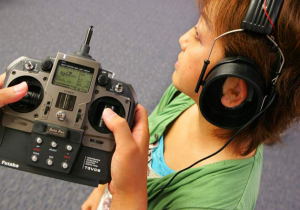
AP Photo/Itsuo Inouye
AP Reporter Yuri Kageyama has written a summary published at LiveScience.com of the day she was “remote-controlled” while visiting a research center in Japan. Nippon Telegraph & Telephone Corp., a Japanese telephone company, has created a headset that delivers a low voltage electric current that can be controlled remotely and affects the balance and movement of the wearer. NTT is developing this technology to use in video games and amusement park rides, although Ms. Kageyama sees less benign applications for the system.
The process by which electric current affects the balance-controlling nerves of the inner ear is known as galvanic vestibular stimulation. As the author describes it, when the researcher pushed the joystick to the right, redirecting the current in the headset, she felt an “irresistible urge” to walk to the right in an effort to maintain her balance. Alternating the current from side to side made it difficult for her to walk at all.
As evidence of their entertainment goals, NTT also demonstrated how the system could be synched to a racing car simulation video – the electrical stimulation emphasizing the turns of the imaginary car over it’s curvy course. Another demonstration had the headset paired to music, causing the author’s head to sway and bob with the beat.
While Ms. Kageyama never does say that the sensation is painful or physically uncomfortable, she does make it clear that it is dramatic and impossible to ignore. The overall tone of her article reflects that she found the phenomenon disturbing, and she actually concludes by bluntly stating that she did not like it all.
The full article is available at LiveScience.com: “Remote-Controlled Human: ‘I Didn’t Like that Sensation’“
